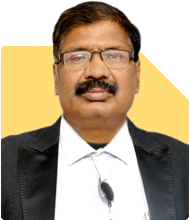JEE Main 2025 75% Percentile ST - Will I Get Top NIT?
Rajesh Kumar Singh | Answer |Ask -Follow
IIT-JEE, GATE Expert - Answered on Mar 21, 2025
During his career, he has served as the head of the mining department and as vice president of Balasore Alloys. He is currently a visiting professor at Mewar University where he teaches BTech students.
Rajesh Kumar topped his batch in BTech mining from BIT, Sindri.
A gold medallist, he has cracked the GATE (Graduate Aptitude Test in Engineering) twice -- in 1993 and 1994 -- with an All India Rank of 14 in 1994.
He has also cleared the Indian Institute of Corporate Affairs (IICA) Independent Director Test.... more

I got 75 percentile jeemains 2025 first session st category,I will get top nit,
You may like to see similar questions and answers below
Prof Suvasish Mukhopadhyay | Answer |Ask -Follow
Career Counsellor - Answered on Feb 22, 2025
Mayank Chandel |2576 Answers |Ask -Follow
IIT-JEE, NEET-UG, SAT, CLAT, CA, CS Exam Expert - Answered on Mar 19, 2025
Prof Suvasish Mukhopadhyay | Answer |Ask -Follow
Career Counsellor - Answered on Apr 09, 2025
Prof Suvasish Mukhopadhyay | Answer |Ask -Follow
Career Counsellor - Answered on Jul 17, 2025
Ramalingam Kalirajan |10906 Answers |Ask -Follow
Mutual Funds, Financial Planning Expert - Answered on Dec 19, 2025
Nayagam P P |10859 Answers |Ask -Follow
Career Counsellor - Answered on Dec 19, 2025
Ramalingam Kalirajan |10906 Answers |Ask -Follow
Mutual Funds, Financial Planning Expert - Answered on Dec 19, 2025
Ramalingam Kalirajan |10906 Answers |Ask -Follow
Mutual Funds, Financial Planning Expert - Answered on Dec 19, 2025
Ramalingam Kalirajan |10906 Answers |Ask -Follow
Mutual Funds, Financial Planning Expert - Answered on Dec 19, 2025
Radheshyam Zanwar |6751 Answers |Ask -Follow
MHT-CET, IIT-JEE, NEET-UG Expert - Answered on Dec 19, 2025
Radheshyam Zanwar |6751 Answers |Ask -Follow
MHT-CET, IIT-JEE, NEET-UG Expert - Answered on Dec 19, 2025
Samraat Jadhav |2514 Answers |Ask -Follow
Stock Market Expert - Answered on Dec 18, 2025
Reetika Sharma |432 Answers |Ask -Follow
Financial Planner, MF and Insurance Expert - Answered on Dec 18, 2025
Reetika Sharma |432 Answers |Ask -Follow
Financial Planner, MF and Insurance Expert - Answered on Dec 18, 2025


























